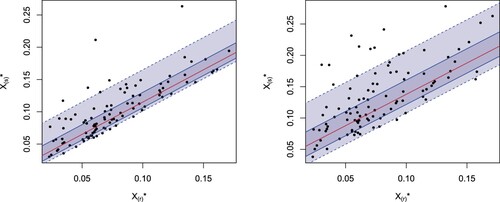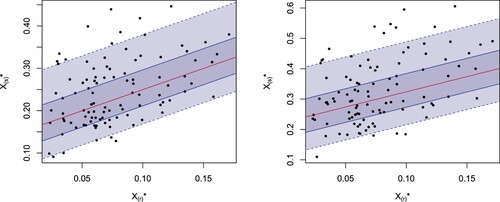Figures & data
Figure 1. Absolute value differences between generalized order statistics and predictions with known parameter ϑ based on the median (black circles) or the mean (red squares) and with unknown parameter ϑ based on the median (blue triangles) or the mean (green stars) from the simulated sample in Example 5.1 with m = 20, and s−r = 1 (left). Predictions (red) for from
for m = 20, s−r = 1, for the exponential distribution in Example 5.1. The black points are the observed values and the blue lines are the limits for the
(continuous lines) and the
(dashed lines) prediction intervals (right).
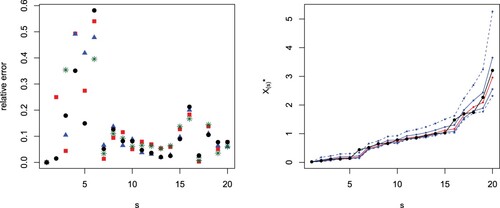
Figure 2. Absolute value differences between generalized order statistics and predictions with known parameter ϑ based on the median (black circles) or the mean (red squares) and with unknown parameter ϑ based on the median (blue triangles) or the mean (green stars) from the simulated sample in Example 5.1 with m = 20, and s−r = 2 (left). Predictions (red) for from
for m = 20, s−r = 2, for the exponential distribution in Example 5.1. The black points are the observed values and the blue lines are the limits for the
(continuous lines) and the
(dashed lines) prediction intervals (right).
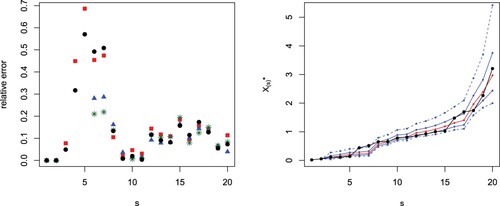
Table 1. Predicted values based on the median from
assuming known ϑ in Example 5.1 for some choices of r and s such that
. In the bottom line we provide the exact values.
Table 2. Number of exact values out of the 50% and prediction intervals with fixed r in the sample of size 20 considered in Example 5.1.
Table 3. Predicted values based on the mean from
assuming known ϑ in Example 5.1 for some choices of r and s such that
. In the bottom line we provide the exact values.
Table 4. Predicted values based on the median from
assuming unknown ϑ in Example 5.1 for some choices of r and s such that
. In the bottom line we provide the exact values.
Table 5. Predicted values based on the mean from
assuming unknown ϑ in Example 5.1 for some choices of r and s such that
. In the bottom line we provide the exact values.
Figure 3. Absolute value differences between generalized order statistics and predictions with known parameter ϑ based on the median (black circles) or the mean (red squares) and with unknown parameter ϑ based on the median (blue triangles) or the mean (green stars) from the simulated sample in Example 5.2 with m = 20, and s−r = 1 (left). Predictions (red) for from
for m = 20, s−r = 1, for the exponential distribution in Example 5.2. The black points are the observed values and the blue lines are the limits for the
(continuous lines) and the
(dashed lines) prediction intervals (right).
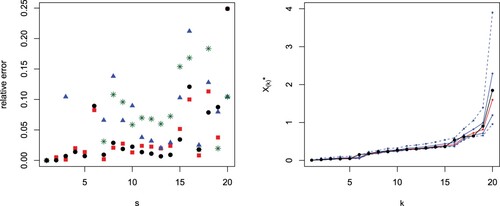
Figure 4. Absolute value differences between generalized order statistics and predictions with known parameter ϑ based on the median (black circles) or the mean (red squares) and with unknown parameter ϑ based on the median (blue triangles) or the mean (green stars) from the simulated sample in Example 5.2 with m = 20, and s−r = 2 (left). Predictions (red) for from
for m = 20, s−r = 2, for the exponential distribution in Example 5.2. The black points are the observed values and the blue lines are the limits for the
(continuous lines) and the
(dashed lines) prediction intervals (right).
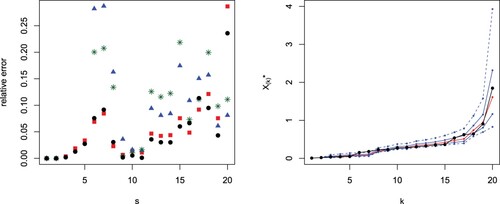
Table 6. Predicted values based on the median from
assuming known ϑ in Example 5.2 for some choices of r and s such that
. In the bottom line we provide the exact values.
Table 7. Number of exact values out of the 50% and prediction intervals with fixed r in the sample of size 20 considered in Example 5.2.
Table 8. Predicted values based on the mean from
assuming known ϑ in Example 5.2 for some choices of r and s such that
. In the bottom line we provide the exact values.
Table 9. Predicted values based on the median from
assuming unknown ϑ in Example 5.2 for some choices of r and s such that
. In the bottom line we provide the exact values.
Table 10. Predicted values based on the mean from
assuming unknown ϑ in Example 5.2 for some choices of r and s such that
. In the bottom line we provide the exact values.

